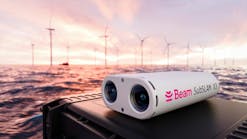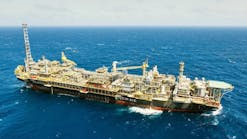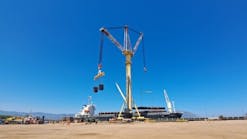Gene Kliewer • Houston
Preliminary "in-house" reserves estimates of the Tui oil fields by AWE indicate that initial proved + probable (2P) reserves recoverable from the fields will be reduced from the previously reported 50.5 MMbbl.
Venture partner Pan Pacific Petroleum (PPP) estimates the reduction at 10-15%, but further detailed technical work will be required for final determination.
AWE's assessment of the production from the existing Tui wells indicates that 40-42 MMbbls can be produced from the existing infrastructure. PPP says this equates to proved (1P) reserves of 41 MMbbls. AWE has identified additional potential infill drilling opportunities and is assessing whether or not these are development candidates and can be assigned to 2P reserves.
Incremental 2P reserves will require some additional investment to produce. The Tui area fields have proved a very successful project, and total production at end June was 30.1 MMbbls.
Participants in PMP 38158 are Pan Pacific Petroleum NL, 10.0% (through wholly owned subsidiary WM Petroleum Ltd); AWE Ltd. (operator), 42.5%; Mitsui E&P Australia Pty Ltd, 35.0%; and Stewart Petroleum Co Ltd (NZOG), 12.5%.
New subsea equipment hits the market
Fugro has added six new Saab Seaeye ROVs to its fleet in the first half of 2011. It also updated three of its existing Seaeye ROVs. The newbuild order is for four Lynx and two Panther XT systems.
"The new ROV systems are already en route to Singapore, Brazil, and the UK, where they will operate in support of drilling and completion; offshore construction; inspection, repair and maintenance; and long- term "Life of Field" support," said Jim Mann, Fugro's global ROV manager.
For its inspection role, each Lynx has cameras and sonar, along with a manipulator and tooling skid. The Panthers are configured for light intervention work and survey tasks. In addition to the composite video and serial data transmission via fiber optic cables, some of the systems have an Ethernet high speed data link for use with advanced sensors such as multi-beam sonar.
Kreuz Subsea also has added a Saab Seaeye Cougar XT to its ROV fleet. The configuration includes a Tritech Super SeaKing sonar, Kongsberg high-definition/low-light camera, color zoom camera, dual five-function manipulator, and CP proximity and contact probe.
SeeByte says it plans to license sonar analytics software to BlueView Technologies. The two companies have cooperated in the past, and Jason Seawall, COO of BlueView noted that "having successfully worked with SeeByte in the past and witnessed the impact of their software when utilized with our sonar, we believe that this agreement will take BlueView to a new level by enabling advanced features that our customers will value."
SECC Oil & Gas has released a new emergency disconnect for subsea equipment. The Mid Line Valved Breakaway Connector is SECC's latest full-bore, pressure-balanced connectors. SECC says the pressure-balanced feature means automatic or manual breakaway under full working pressure and at depths of 10,000 ft (3,048 m) or more instantly seals each section of the line, resulting in no risk of fluid spill.
New subsea compression plans for Norwegian Sea
Statoil and its partners in the Åsgard licenses in the Norwegian Sea plan to implement subsea gas compression. The aim is to sustain production from the Mikkel and Midgard reservoirs.
Øystein Michelsen, Statoil's executive VP for Development and Production Norway, presented the proposals to Ola Borten Moe, Norway's minister for Petroleum and Energy.
Subsea compression on Åsgard should improve recovery from Mikkel and Midgard by 278 MMboe. The two fields are 40-50 km (24.8-31 mi) from the Åsgard B platform, which processes their output.
In time, the natural pressure in these two fields is expected to become too low to maintain stable flow and a high production profile from Åsgard B.
To offset the decline, Statoil intends to install seabed compressors near the wellheads to increase the pressure. Well streams will go through a common pipeline to Åsgard B.
The proposed concept calls for one subsea template with two compressors, coolers, separators and pumps, and powered by a submarine cable. Modification work will be performed on both Åsgard B and the Åsgard A production ship. Subsea compression should also expand capacity in the Åsgard Transport pipeline.
The cost of the investment is estimated at NOK 15 billion ($2.757 billion), with a projected start-up of 1Q 2015.
Subsea vessel demand to grow 52% to 2015, says Douglas-WestwoodThe demand for subsea vessel operations is set to grow by 52%, totaling $72 billion between 2011 and 2015, according to a new Douglas-Westwood report. The "World Subsea Vessel Operations Market 2011-2015" also says project timetables are accelerating, project capex is increasing, and global demand for subsea vessels is expected to exceed 310,000 days over the period, an increase of 28% on the previous five years. Spending over the period is expected to rise from $11.2 billion this year to $19 billion in 2015, the report predicts. It includes vessels used for subsea field development and construction, inspection/repair/maintenance, well intervention, and P&A activity. |
Offshore Articles Archives
View Oil and Gas Articles on PennEnergy.com







